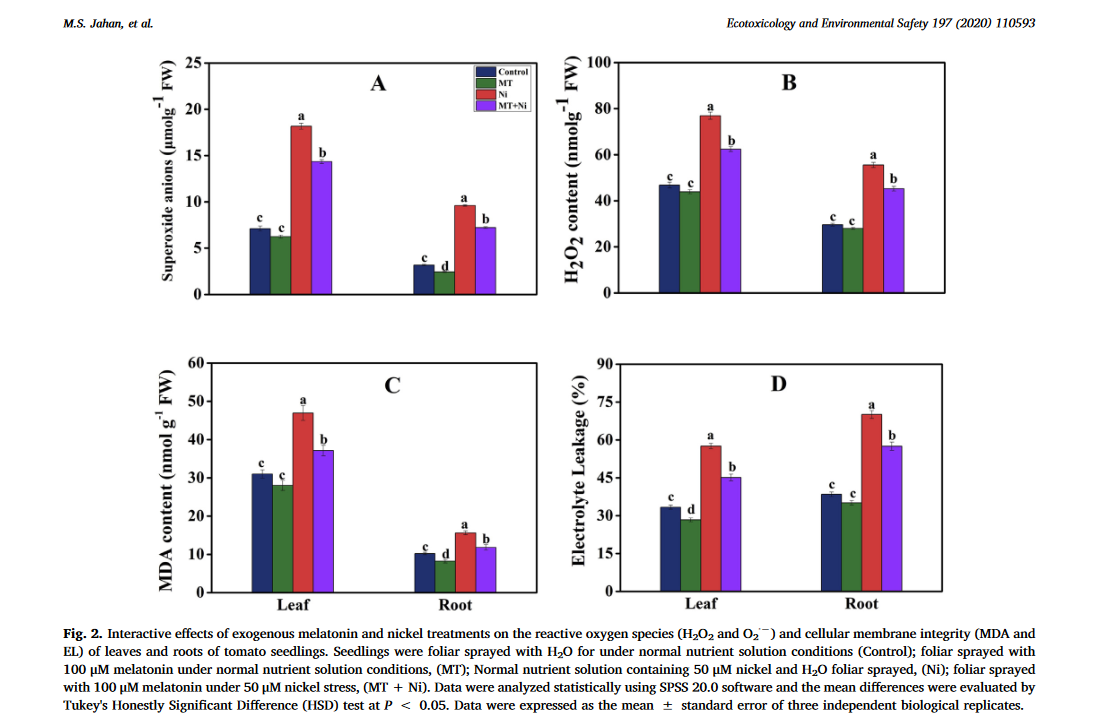Melatonin alleviates nickel phytotoxicity by improving photosynthesis, secondary metabolism and oxidative stress tolerance in tomato seedlings
Abdul RaziqBalochaJinSunaShengShuaYuWangaGolam JalalAhammedcKhairulKabirbRanaRoyde
- aKey Laboratory of Southern Vegetable Crop Genetic Improvement in Ministry of Agriculture, College of Horticulture, Nanjing Agricultural University, Nanjing, 210095, People’s Republic of China
- bDepartment of Horticulture, Faculty of Agriculture, Sher-e-Bangla Agricultural University, Dhaka, 1207, Bangladesh
- cCollege of Forestry, Henan University of Science and Technology, Luoyang, 471023, PR China
- dCollege of Resource and Environment, Northwest A&F University, Yangling, Shaanxi, 712100, China
- eDepartment of Agroforestry and Environmental Science, Sylhet Agricultural University, Sylhet, 3100, Bangladesh
Abstract
Arable land contamination with nickel (Ni) has become a major threat to worldwide crop production. Recently, melatonin has appeared as a promising stress-relief substance that can alleviate heavy metal-induced phytotoxicity in plants. However, the plausible underlying mechanism of melatonin function under Ni stress has not been fully substantiated in plants. Herein, we conducted an experiment that unveiled critical mechanisms in favor of melatonin-mediated Ni-stress tolerance in tomato. Ni stress markedly inhibited growth and biomass by impairing the photosynthesis, photosystem function, mineral homeostasis, root activity, and osmotic balance. In contrast, melatonin application notably reinforced the plant growth traits, increased photosynthesis efficiency in terms of chlorophyll content, upregulation of chlorophyll synthesis genes, i.e. POR, CAO, CHL G, gas exchange parameters, and PSII maximum efficiency (Fv/Fm), decreased Ni accumulation and increased mineral nutrient homeostasis. Moreover, melatonin efficiently restricted the hydrogen peroxide (H2O2) and superoxide radical production and increased RBOH expression and restored cellular integrity (less malondialdehyde and electrolyte leakage) through triggering the antioxidant enzyme activities and modulating AsA-GSH pools. Notably, oxidative stress was effectively mitigated by upregulation of several defense genes (SOD, CAT, APX, GR, GST, MDHAR, DHAR) and melatonin biosynthesis-related genes (TDC, T5S, SNAT, ASMT). Besides, melatonin treatment enhanced secondary metabolites (phenols, flavonoids, and anthocyanin) contents along with their encoding genes (PAL, CHS) expression, and these metabolites potentially restricted excess H2O2 accumulation. In conclusion, our findings deciphered the potential functions of melatonin in alleviating Ni-induced phytotoxicity in tomato through boosting the biomass production, photosynthesis, nutrient uptake, redox balance, and secondary metabolism.

